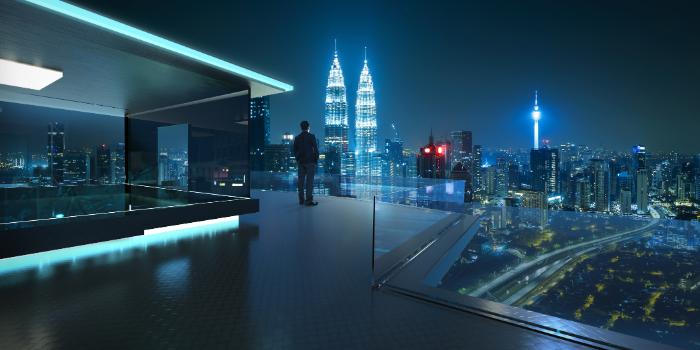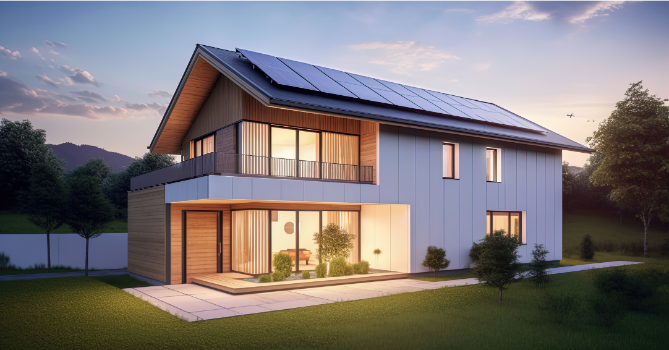
Bio-Materials and Sustainable Design: Shaping the Cities of Tomorrow
In today's rapidly changing world, sustainability has become a crucial consideration in urban development. As cities grow and infrastructure expands, the need for sustainable solutions becomes more pressing. This blog explores the rise of sustainable cities and infrastructure, shedding light on the challenges and opportunities in creating greener, more resilient urban environments.
With the increasing awareness of climate change and environmental degradation, there is a growing consensus on the importance of sustainable development. From renewable energy sources to eco-friendly building materials, cities around the world are embracing innovative approaches to reduce their carbon footprint and enhance quality of life for residents.
In this blog, we'll delve into the key factors driving the shift towards sustainability in urban planning and infrastructure development. From the use of bio-materials to address environmental concerns to the integration of smart technologies for efficient resource management, we'll explore the diverse strategies employed to build a greener future for our cities. Join us as we uncover the trends shaping the sustainable cities of tomorrow.
Sustainable urbanization refers to the development of cities and urban areas in a way that meets the needs of the present without compromising the ability of future generations to meet their own needs. It encompasses various principles and practices aimed at minimizing environmental impact, promoting social equity, and fostering economic prosperity.
One key aspect of sustainable urbanization is efficient land use planning. This involves designing cities in a way that maximizes the use of available land while minimizing sprawl and preserving natural habitats. By compacting development and promoting mixed land use, cities can reduce the need for long commutes and promote more sustainable transportation options like walking, cycling, and public transit.
Another important consideration in sustainable urbanization is the integration of green infrastructure. Green spaces such as parks, urban forests, and green roofs not only enhance the aesthetic appeal of cities but also provide numerous environmental benefits, including improved air quality, stormwater management, and biodiversity conservation.
Additionally, sustainable urbanization involves the adoption of resource-efficient building practices and the use of eco-friendly materials in construction. Buildings account for a significant portion of energy consumption and greenhouse gas emissions in urban areas, so incorporating energy-efficient design features and renewable energy technologies can help reduce their environmental footprint.

Furthermore, sustainable urbanization prioritizes social equity and inclusivity, ensuring that all residents have access to essential services, amenities, and opportunities for economic advancement. This includes affordable housing, healthcare, education, and employment opportunities, as well as safe and accessible public spaces for recreation and social interaction.
Overall, sustainable urbanization is essential for creating cities that are resilient, livable, and environmentally responsible. By adopting holistic approaches to urban planning and development, cities can address the complex challenges of rapid urbanization while building a more sustainable future for all.
Bio-materials play a crucial role in sustainable design by offering eco-friendly alternatives to traditional building materials. These materials are derived from renewable resources such as plants, agricultural waste, and recycled materials, making them more sustainable and environmentally friendly.
One of the key benefits of bio-materials is their low environmental impact. Unlike conventional building materials like concrete and steel, which require significant energy and resources to produce, bio-materials can be produced with minimal environmental impact. For example, bamboo, a commonly used bio-material, grows rapidly and requires little water and pesticides, making it a highly sustainable option for construction.
Bio-materials also have the advantage of being biodegradable or compostable, reducing waste and minimizing the environmental footprint of buildings. Materials such as straw bales, wood, and cork can be easily recycled or returned to the earth at the end of their life cycle, reducing the need for landfill space and conserving natural resources.
Furthermore, bio-materials offer excellent thermal insulation properties, helping to improve the energy efficiency of buildings and reduce heating and cooling costs. Materials like straw bales, hempcrete, and wool insulation provide natural insulation that can help maintain comfortable indoor temperatures year-round, reducing the need for mechanical heating and cooling systems.
In addition to their environmental and performance benefits, bio-materials also contribute to the aesthetic appeal of sustainable design. Many bio-materials have unique textures, colors, and patterns that add visual interest and character to buildings, creating spaces that are both functional and visually appealing.
Overall, the use of bio-materials in sustainable design offers a promising pathway towards creating buildings that are more environmentally friendly, resource-efficient, and aesthetically pleasing. By incorporating bio-materials into building projects, architects and designers can help reduce the environmental impact of construction and create healthier, more sustainable built environments for present and future generations.

Technological innovations are playing a pivotal role in driving sustainability in urban development and infrastructure. One such innovation is the advancement of renewable energy technologies, such as solar panels, wind turbines, and geothermal systems. These technologies harness natural resources like sunlight, wind, and heat from the earth to generate clean and renewable energy, reducing reliance on fossil fuels and lowering greenhouse gas emissions.
Another key innovation is the development of smart grid systems and energy-efficient infrastructure, which enable more efficient distribution and management of energy resources. Smart grid technologies integrate advanced sensors, meters, and communication networks to optimize energy usage, reduce waste, and enhance overall grid reliability and resilience.
Additionally, advancements in green building materials and construction techniques are driving sustainability in the built environment. Innovations such as low-emission concrete, recycled materials, and modular construction methods are helping to minimize the environmental impact of construction projects and create healthier, more energy-efficient buildings.
Furthermore, the rise of digital technologies and data analytics is revolutionizing urban planning and management. Tools like Geographic Information Systems (GIS), Building Information Modeling (BIM), and real-time monitoring systems enable city planners and policymakers to make data-driven decisions and optimize resource allocation, infrastructure design, and transportation systems for greater sustainability.
Overall, technological innovations are empowering cities and communities to transition towards more sustainable and resilient infrastructure systems. By embracing these innovations, urban areas can mitigate the impacts of climate change, reduce energy consumption, and create healthier, more livable environments for residents now and in the future.
Urbanization presents numerous challenges, including increased pressure on infrastructure, limited access to affordable housing, environmental degradation, and social inequality. Addressing these challenges requires a multifaceted approach that integrates sustainable urban planning, equitable development strategies, and innovative solutions.
One key aspect of addressing urbanization challenges is implementing sustainable land-use planning and development policies. This involves promoting compact, mixed-use development patterns that minimize sprawl, reduce transportation emissions, and preserve green spaces. By focusing development in existing urban areas and promoting transit-oriented development, cities can improve access to amenities, reduce commute times, and enhance overall livability.
Another critical component is ensuring access to affordable housing for all residents, particularly low-income and marginalized communities. This may involve implementing inclusionary zoning policies, providing subsidies for affordable housing development, and investing in social housing initiatives. By prioritizing affordability and inclusivity in housing policies, cities can mitigate displacement, improve housing stability, and foster social cohesion.
Additionally, addressing environmental challenges associated with urbanization requires implementing sustainable infrastructure and resource management practices. This includes investing in renewable energy, green building technologies, and efficient water and waste management systems. By adopting sustainable infrastructure solutions, cities can reduce carbon emissions, conserve natural resources, and enhance resilience to climate change impacts.
Furthermore, addressing social inequality and promoting social inclusion is essential for creating equitable and sustainable cities. This involves ensuring access to quality education, healthcare, and public services for all residents, regardless of socioeconomic status. It also requires fostering inclusive governance processes that empower marginalized communities and ensure their voices are heard in decision-making processes.
Overall, addressing the challenges of urbanization requires a comprehensive and collaborative approach that integrates sustainable urban planning, equitable development strategies, and community engagement. By working together to implement innovative solutions, cities can create more resilient, inclusive, and sustainable urban environments for all residents.
The future of urbanization holds promising opportunities for creating greener, more sustainable cities. As cities continue to grow and evolve, there is a growing recognition of the importance of integrating sustainability principles into urban planning and development.
One key trend shaping the future of urbanization is the increasing adoption of green building practices and sustainable design strategies. From energy-efficient buildings to green roofs and urban agriculture initiatives, cities are embracing innovative approaches to reduce their environmental footprint and enhance resilience to climate change.
Technological advancements also play a crucial role in shaping the future of urban sustainability. Emerging technologies such as smart grids, energy-efficient appliances, and renewable energy systems are transforming how cities manage resources and deliver services. Additionally, the rise of digital technologies and data analytics enables cities to optimize resource allocation, improve mobility, and enhance overall quality of life for residents.
Furthermore, there is a growing emphasis on promoting biodiversity and green spaces within cities. Urban forestry initiatives, green corridors, and parks play a vital role in mitigating the urban heat island effect, improving air quality, and providing recreational opportunities for residents.
Another important aspect of the future outlook for greener cities is the increasing emphasis on social equity and community engagement. As cities strive to become more sustainable, it is essential to ensure that these efforts benefit all residents, especially those in underserved and marginalized communities.
In conclusion, the future of urbanization is bright with possibilities for creating greener, more sustainable cities. By embracing innovative technologies, promoting biodiversity, and prioritizing social equity, cities can pave the way towards a more sustainable and resilient future for all.
In conclusion, the rise of sustainable cities and infrastructure represents a pivotal moment in urban development. As cities continue to grow and face increasing environmental challenges, there is a pressing need for innovative solutions that prioritize sustainability and resilience. By integrating bio-materials, embracing technological innovations, and addressing the challenges of urbanization head-on, cities can pave the way towards a greener, more sustainable future. However, achieving this vision will require collaboration across sectors, strong leadership, and a commitment to meaningful change. With concerted efforts and collective action, we have the opportunity to build cities that are not only environmentally sustainable but also inclusive, equitable, and prosperous for all residents. The journey towards sustainable urbanization is ongoing, but with determination and foresight, we can create cities that thrive in harmony with nature and contribute to a more sustainable planet for generations to come.